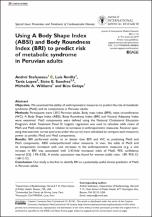Mostrar el registro sencillo del ítem
Using a body shape index (ABSI) and body roundness index (BRI) to predict risk of metabolic syndrome in peruvian adults
| dc.contributor.author | Stefanescu, Andrei | |
| dc.contributor.author | Revilla, Luis | |
| dc.contributor.author | Lopez, Tania | |
| dc.contributor.author | Sanchez, Sixto E. | |
| dc.contributor.author | Williams, Michelle A. | |
| dc.contributor.author | Gelaye, Bizu | |
| dc.date.accessioned | 2020-06-23T16:13:13Z | |
| dc.date.available | 2020-06-23T16:13:13Z | |
| dc.date.issued | 2019-05-30 | |
| dc.identifier.citation | Stefanescu A., Revilla L., Lopez T., Sanchez SE., Williams MA., Gelaye B. Using a body shape index (ABSI) and body roundness index (BRI) to predict risk of metabolic syndrome in peruvian adults. Journal of International Medical Research. 2019; 48(1): 1-12. | es_PE |
| dc.identifier.uri | https://hdl.handle.net/20.500.12727/6242 | |
| dc.description.abstract | Objective We examined the ability of anthropometric measures to predict the risk of metabolic syndrome (MetS) and its components in Peruvian adults. Methods Participants were 1,815 Peruvian adults. Body mass index (BMI), waist circumference (WC), A Body Shape Index (ABSI), Body Roundness Index (BRI) and Visceral Adiposity Index were examined. MetS components were defined using the National Cholesterol Education Program’s Adult Treatment Panel III. Logistic regression was used to calculate odds ratios of MetS and MetS components in relation to increases in anthropometric measures. Receiver operating characteristic curves (and area under the curve) were calculated to compare each measure’s power to predict MetS and MetS components. Results BRI performed similar to or better than BMI and WC at predicting MetS and MetS components. ABSI underperformed other measures. In men, the odds of MetS and its components increased with unit increases in the anthropometric measures (e.g. a unit increase in BRI was associated with 2.43-fold increased odds of MetS; 95% confidence interval [CI]: 1.95–3.02). A similar association was found for women (odds ratio: 1.89; 95% CI: 1.68–2.12). Conclusion Our study is the first to identify BRI as a potentially useful clinical predictor of MetS in Peruvian adults. | es_PE |
| dc.description.sponsorship | Dirección General de Epidemiología del Ministerio de Salud, Perú. Instituto Nacional de Salud, Perú. Institutos Nacionales de Salud, Centro Nacional de Salud de las Minorías y Disparidades de Salud (T37-MD001449). | es_PE |
| dc.format.extent | pp. 1-12 | es_PE |
| dc.language.iso | eng | es_PE |
| dc.publisher | SAGE Publishing | es_PE |
| dc.relation.ispartof | urn:issn:2183-6051 | |
| dc.relation.ispartofseries | Journal of International Medical Research;vol. 48, no. 1 | |
| dc.relation.uri | https://doi.org/10.1177/0300060519848854 | es_PE |
| dc.rights | info:eu-repo/semantics/openAccess | es_PE |
| dc.rights.uri | https://creativecommons.org/licenses/by-nc/4.0/ | es_PE |
| dc.source | Repositorio Académico USMP | es_PE |
| dc.source | Universidad San Martín de Porres - USMP | es_PE |
| dc.subject | Síndrome metabólico | es_PE |
| dc.subject | Índice de masa corporal | es_PE |
| dc.subject | Circunferencia de la cintura | es_PE |
| dc.subject | Adiposidad | es_PE |
| dc.title | Using a body shape index (ABSI) and body roundness index (BRI) to predict risk of metabolic syndrome in peruvian adults | es_PE |
| dc.type | info:eu-repo/semantics/article | es_PE |
| thesis.degree.name | Medicina Humana | es_PE |
| thesis.degree.grantor | Universidad de San Martín de Porres. Facultad de Medicina Humana | es_PE |
| thesis.degree.discipline | Medicina | es_PE |
| dc.subject.ocde | https://purl.org/pe-repo/ocde/ford#3.02.00 | es_PE |
Ficheros en el ítem
Este ítem aparece en la(s) siguiente(s) colección(es)
-
Artículos [274]








